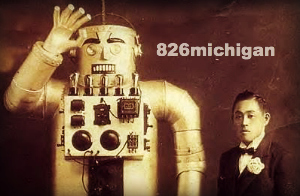MARK: Your work came to the attention of a number of us here in Michigan a few days ago, when you penned an article for Salon entitled “Welcome to Michissippi.” The title of the article, if I’m not mistaken, after being online for a day or so, was then changed to, “Right-to-work bill: Michigan just gives up.” I realize that authors rarely choose their own headlines, and that you might be bit out of the loop as to why the change was made, but, before we get into the content of the article, and your thoughts on the future of Michigan, I thought that I’d ask if you knew what motivated the change. Was it seen as too inflammatory? Did people complain? Or did they just decide to focus on the right-to-work angle as it was the hot topic of the day, having just passed?
TED: I was the one who suggested the “Welcome to Michissippi” headline. It was used as a cover on the main website, and, then, when you clicked through, the “Michigan gives up” headline appeared. I was worried that it wouldn’t be understood by people outside of Michigan, but it seems to have attracted a lot of attention from Michiganders.
MARK: This isn’t really a question, but I’d like to thank you for lighting a fire beneath our collective ass by saying in the national press what a lot of us have been saying here in Michigan for years… that instead of positioning ourselves to be successful in the future, we’re positioning ourselves to be a third-tier state.
TED: I’ve been writing about this for 20 years. I wrote an essay called “Living the Lansing Dream” for Gen X anthology called “Next: Young American Writers on the New Generation ” in 1994. The Lansing dream was moving away from Lansing. The right-to-work bill showed me the consequences of the outmigration I’ve been part of. As Michigan becomes older and less educated, it becomes more reactionary.
” in 1994. The Lansing dream was moving away from Lansing. The right-to-work bill showed me the consequences of the outmigration I’ve been part of. As Michigan becomes older and less educated, it becomes more reactionary.
MARK: Do you think the passage of that bill that had more to do with the outmigration of young, educated Michiganders, or the fact that labor union membership and activity has been waning in recent years?
TED: I think it’s the fact that labor union activity has been waning for decades in Michigan. For a long time it wasn’t certain whether the United Auto Workers was a special interest in the Michigan Democratic Party or the Michigan Democratic Party was special-interest of the United Auto Workers. As the UAW got weaker the Democrats got weaker, and the Republicans saw a chance to weaken them both even further.
MARK: Your article in Salon, for those folks in the audience who haven’t read it, has at it’s core the vastly uneven rivalry between Chicago and Michigan over young, talented, college-educated workers. From my own perspective, as a Michigander who has seen a number of bright friends migrate to Chicago (and elsewhere), my sense is that it’s a huge and growing problem, but I’ve never seen hard data from the State of Michigan, the University of Michigan, or Michigan State, for instance, to confirm that suspicion. Do we know definitively how many of our college graduates each year make their way to Chicago? And do we know for certain that it’s getting worse?
TED: There was a Detroit News series in 2010 that said half the recent Michigan State college graduates left the state immediately, and the city with the most recent graduates is Chicago. In Chicago, there’s a bar for every Big Ten school, but Michigan State has 14. That’s more than the University of Illinois. I interviewed an engineering grad from Michigan who’d grown up in Detroit, and I asked him whether he’d have an easier time finding his classmates there, or in Chicago. He looked at me like I was an idiot. “Oh, Chicago, of course,” he said.
MARK: I think that most of us have that same impression, but I don’t know that there are definitive numbers. And, in absence of them, it’s hard to know whether we’re moving in the right direction. At any rate, the State at least says that reversing the brain drain is a priority. For the past few years, the Michigan Economic Development Corporation has been pursuing a campaign called “MichAGAIN,” with the intention of luring some of these folks back. I suspect they’ve done a significant amount of polling, but I don’t know, however, if they’ve ever shared their findings. Would you happen to know whether or not the campaign has been successful?
TED: I’ve not heard of that campaign. Nobody contacted me and asked me to come back.
MARK: Here, in case you’re interested, is a quote from Michigan Economic Development Corporation President and CEO Michael Finney, taken from the most recent MichAGAIN newsletter, which, in case you’re interested, invites Michigan ex-pats, like yourself, to attend a reception on December 27, at the Renaissance Center, to find out about employment opportunities in the state. “We have a message for Michigan natives who moved away in difficult times: today’s Michigan is not the Michigan you left behind,” said Finney. “Employers are hiring, new businesses are calling Michigan home, and the entrepreneurial spirit that built this great state is alive and well. Michigan needs your talent and experience to insure our businesses will continue to thrive and help grow the state’s economy.” The newsletter then goes on to rattle off a number of facts concerning the economic climate in Michigan. Among these are a Comerica report stating that our “economic activity index” is at a 10-year high, and one from the Bay Area Council Economic Institute stating that we’re the 3rd-best state in the nation when it comes to high tech job growth. I know they’re hosting events in Chicago as well. Do you get the sense that people are buying it?
TED: I’ve always said that Michigan didn’t become great because of the auto industry, the auto industry became great because of a Michigander. Michiganders are creative and entrepreneurial people; however, as I pointed out in the Salon article, the greatest tycoon Michigan has produced in this century is Larry Page, and he lives in California.
MARK: In your article for Salon, you say that, twenty years ago, after graduating from Michigan State, you moved to Chicago, along with all of your friends. As things in Michigan weren’t so terrible 20 years ago, at least relative to today, would I be right to assume that there were others things luring you there? In other words, as much as I’d like to attribute the brain drain to economics and politics, isn’t it probably true that a great many young people move to Chicago because it’s a relatively functional large city, where a lot of interesting things are happening, and where there’s a sizable dating pool? Which isn’t to say, of course, that politics and economics haven’t played a part in keeping Detroit from becoming such a destination. It may be a distinction without a difference, but I wonder if, in other words, we’re losing the war with Chicago just because we don’t have a thriving metropolis during a period in our history when bright young people are being disproportionately drawn to cities.
TED: Twenty years ago, the country was in a recession, and Detroit’s murder rate was its all-time high, because of the crack wars. When I graduated from MSU’s College of Arts and Letters, I don’t think any of the people surrounding me at commencement had a full-time job. I actually lived in Washington D.C., and Decatur, Illinois, working on a newspaper, for two and half years before I moved to Chicago. But so many of my friends from Lansing had moved there, I was able to plug right into a community. It was like being an immigrant. I think young people have always been drawn to cities. One thing I learned is that Chicago’s success comes at the expense of the other cities in the region. There can only be one Midwestern metropolis. It’s a consequence of globalization. Just as money and education are flowing to fewer people, they’re flowing to fewer cities… The Midwest only has room for one big destination city. The book “Caught in the Middle: America’s Heartland in the Age of Globalism ” by Richard C. Longworth describes this phenomenon well. In its first golden age, from the 1890s to the 1920s, Chicago was luring young people from the farms. Now it’s luring them from the smaller industrial cities.
” by Richard C. Longworth describes this phenomenon well. In its first golden age, from the 1890s to the 1920s, Chicago was luring young people from the farms. Now it’s luring them from the smaller industrial cities.
MARK: That’s awfully fatalistic. If I’m understanding you correctly, you’re saying that Michigan can never compete, as Chicago, having already won the race, and become the dominant regional player, will always attract the best and brightest. Is there really nothing that can be done? Aren’t there other examples of functioning, financially-viable cities existing within a 250-mile radius of a thriving metropolis?
TED: I’ll quote from Dick Longworth’s book: “This is the manufacturing heartland of America, and much of the manufacturing took place in the small towns and cities that radiated out from metropolitan centers such as Chicago or Detroit. The industrial era needed a lot of these cities. The global era doesn’t. Globalization concentrates everything and is concentrating the new workforce-educated knowledge workers, the creative people, the idea-mongers-in cities. You don’t need to scatter the production of ideas across the countryside, as you scattered the production of goods. You need to bring ideas together in one place and let them bounce off each other.” In truth, the best and the brightest have always gone to cities. Skilled, hard-working people with some secondary education could lead a middle class life back in the old home town, working in the local factories. That’s what’s gone now, and it dooms these towns, just as surely as it has doomed the old rusting mill by the tracks.
MARK: Speaking of Michigan cities, I’m curious if you’ve spent much time in Grand Rapids? It pains me to say it a bit, as I’m not a fan of the Amway empire, but it really seems to me that they’ve been doing a lot of things right (i.e. investing in local entrepreneurship, education, sustainability, health care, the arts, etc.), in spite of what’s happening in the rest of the state, where we seem intent on cutting taxes to the point of collapse. While their population numbers certainly aren’t large enough to put them in the same league with Chicago, I wonder whether there may be a lesson to two to be learned from their experience. And I wonder whether any parts of the Grand Rapids model could be replicated elsewhere around the state. Personally, I think it would be difficult, as much of what they’ve done has been made possible by personal philanthropy, the likes of which we don’t see elsewhere in the state, but I think it’s a question worth asking.
TED: I haven’t spent much time in Grand Rapids. I do know it tilts a little more toward Chicago. And, as not everyone wants to live in a big city, Grand Rapids, Kalamazoo, and even Lansing may be good models for people who want a smaller town life.
MARK: A few days ago, after your article was released, our Governor, Rick Snyder, sat down with reporters from the Detroit Free Press, who asked him directly whether or not his recent passage of right-to-work legislation would drive away the young high-tech entrepreneurs, members of the so-called “creative class,” and new graduates. He essentially said that young people don’t care about right-to-work. Is he right?
TED: I don’t know how much they specifically obsess over right-to-work, but as Brian Dickerson pointed out in the Free Press, they want to live in a forward-looking, progressive state, and right to work is a sign of a state moving backwards.
MARK: You mentioned in the Salon article that, six years ago, you attempted to move back to Michigan, but were only able to find one job, which paid $25,000 a year, and offered no vacation time. You, as a result, decided to stay in Chicago. I’m curious if you could speak a bit about the kinds of jobs that you were finding in Michigan at that time, and what, if any, change you’ve seen since then… I don’t know if you’ve looked for a job in Michigan since, but I imagine that, in doing research for your new book, “Nothin’ But Blue Skies: The Heyday, Hard Times, and Hopes of America’s Industrial Heartland ,” you’ve had the occasion to look into hiring trends here, and I’m wondering what you found… The reason I ask is that, in the article, you write, “Michigan has lost so many educated workers that the state’s leadership seems to feel it has no choice but to become a low-wage haven. The kind of place that attracts chicken processors, not software engineers.” And I’m wondering whether the data supports that. Do we know, for instance, that jobs for software engineers are declining, while low-wage jobs are growing?
,” you’ve had the occasion to look into hiring trends here, and I’m wondering what you found… The reason I ask is that, in the article, you write, “Michigan has lost so many educated workers that the state’s leadership seems to feel it has no choice but to become a low-wage haven. The kind of place that attracts chicken processors, not software engineers.” And I’m wondering whether the data supports that. Do we know, for instance, that jobs for software engineers are declining, while low-wage jobs are growing?
TED: Interestingly, I ended up taking a job at a magazine with offices in Northwest Indiana, and I lived in New Buffalo. But I was laid off after a year, and the magazine went out of business a year after that, during the 2008 recession. So I bounced back to Chicago, where I wrote a book about President Obama, so it was all good. Since then, I haven’t had enough confidence in Michigan’s economy to entrust my career to it. In Lansing, I did visit a high-tech business called Niowave, which employs skilled craftsmen to build cyclotrons. Most were retired autoworkers, not earning as much as they had in the shop. An important trend is the auto industry’s two-tier wage system, which starts workers at $14 an hour, half of what their more experienced linemates earn. I think that shows there are not as many high-wage jobs as there used to be, even in supposedly high wage industries. Anecdotally, the shopping center near my mom’s house is now anchored by a Laundromat, a dollar store, and a plasma center.
MARK: Sorry for the detour, but, as you mentioned your earlier book, Young Mr. Obama: Chicago and the Making of a Black President , I’m curious to know if you might have any insight, given what you learned about him as a young politician in Chicago, as to how he might lead in his second term, especially as pertains to this fiscal cliff that we’re now approaching. Also, I’m curious as to how much access you had to him, if any, when writing that book.
, I’m curious to know if you might have any insight, given what you learned about him as a young politician in Chicago, as to how he might lead in his second term, especially as pertains to this fiscal cliff that we’re now approaching. Also, I’m curious as to how much access you had to him, if any, when writing that book.
TED: I had my access to him in 2000 and 2004, when he was running for Congress and Senate. I still have the tape of the nearly 2 hour long interview we did in 2000. As for the fiscal cliff, I tell people “I’m an expert on what Obama did 10 years ago, not what he’s doing now.”


 Here on the site last week, I
Here on the site last week, I  The response to this “
The response to this “











